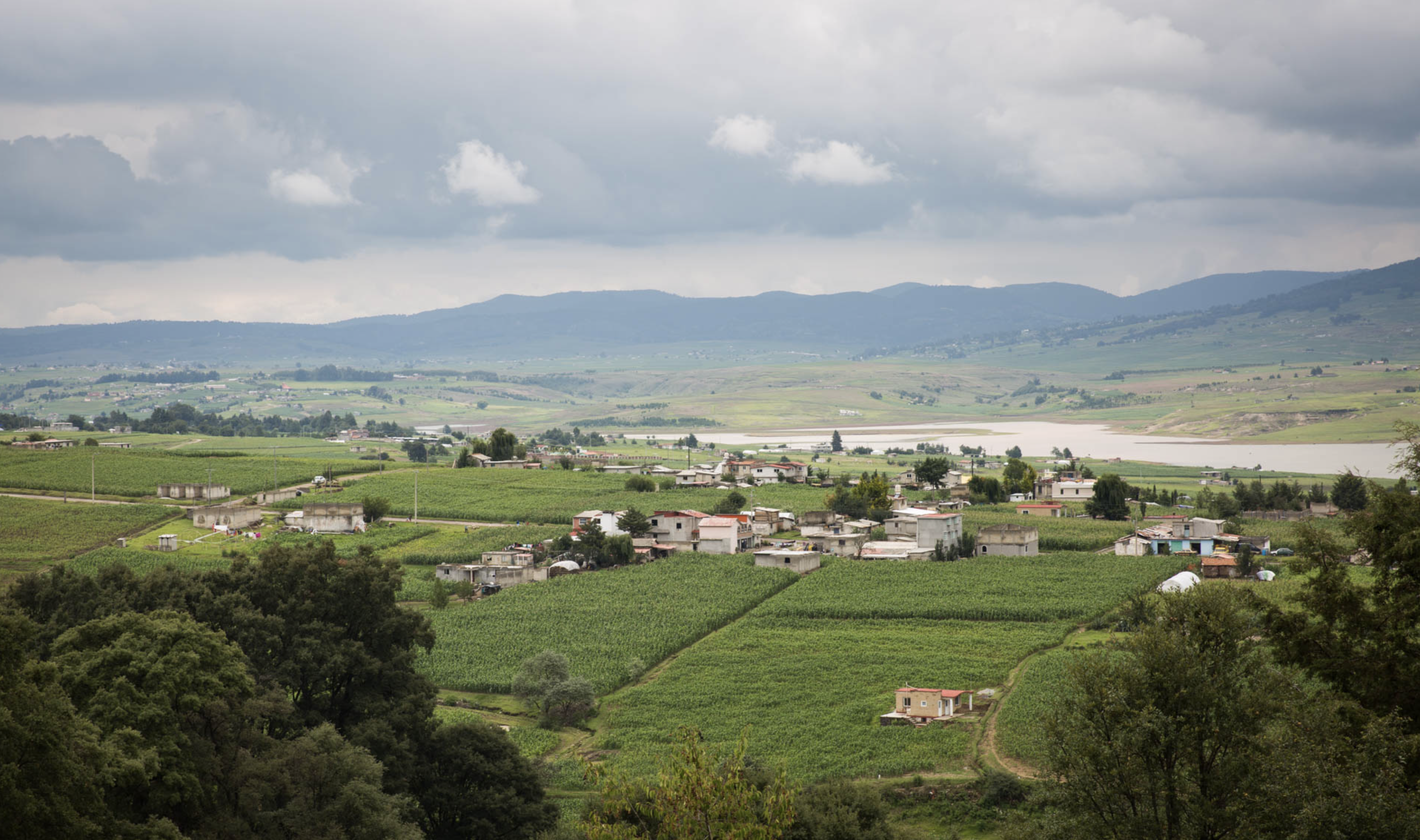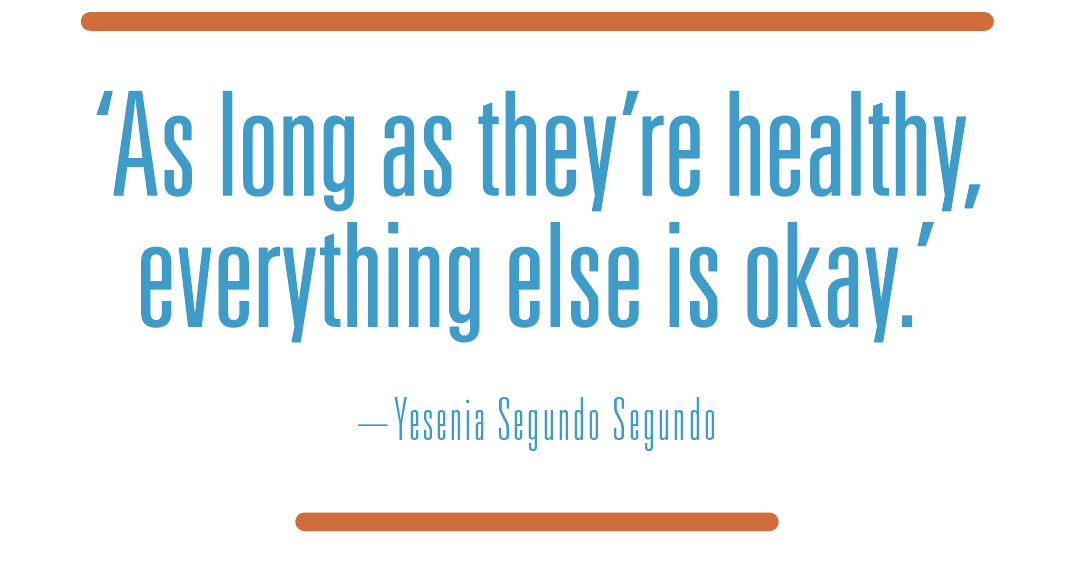Vitamin Angels Bring New Hope to Forgotten People
How Distributing Vitamin A to Small Mexican Villages Changed Lives

Zarahi Pedraza Flores, age 4½, is a patient but exacting Spanish teacher. We sat at her tiny kindergarten desk as she traced her finger around a color wheel, nodding slowly as I eked out the proper names and pronunciations — “rojo, naranja, amarillo.” Then animals. “Gato, perro” — easy enough. Next was “elephant.” I butchered it. Twice. Flores’s eyes narrowed, and her voice rose. “El-e-fan-te!” This time I got it right, and we high-fived.
Flores is growing up in Guadalupe Coté (pictured above), a rural community of 140 indigenous Mazahua families living among cornfields and furled green hills a three-hour drive northwest of Mexico City. Life here is simple and difficult. The men tend crops and look for construction work while the women make crafts and care for the children. Their poverty isn’t crippling, but it’s hobbling. Clean water is a luxury, and recreation a foreign concept. The cost of textbooks and uniforms price many kids out of public school. Undernourishment is a chronic problem.
Like millions of children throughout the developing world, Flores suffered from vitamin A deficiency, the result of not eating enough meat, a rare luxury in her village. Most of her meals consist of tortillas, rice, cactus, and beans. Other sources of vitamin A — such as leafy green vegetables, carrots, and sweet potatoes — simply aren’t available. As a result, because her body thought it was starving, it kicked into famine mode. She began to lose her appetite and didn’t have the energy to play outside or concentrate in school.
Eighteen months ago, Flores began to bounce back. Vitamin Angels, the Santa Barbara–based nonprofit that fights malnutrition all over the globe, started distributing vitamin A to the children in her village. Since 2016, with the help of Mexican field partner ProMazahua, the supplies have benefited more than 10,000 kids living throughout that remote region. More than 275,000 children have been reached through dozens of Mexican field partners. “Thanks to God that he planted in your heart the desire to help people,” Yesenia Segundo Segundo told Vitamin Angels founder and leader Howard Schiffer during his visit to Guadalupe Coté last month.

Her daughters — Ana, age 3, and Atalia, age 5 — joined my little Spanish teacher, Zarahi, in line with 50 other children who took turns tilting back their heads and swallowing a few drops of liquid, vanilla-flavored vitamin A. The concentrated dose is slow-released over time. They also received deworming medication — albendazole — to rid their bodies of parasites that, contracted from drinking dirty water or playing in soil tainted by animal feces, can rob them of a third of their food nutrients.

In 2004, the Danish political scientist Bjørn Lomborg posed a deceptively simple question to top economists and environmental analysts: If we had $50 billion to improve the state of the world, which problem would we solve first to the greatest effect? Dozens of teams of researchers took part in the challenge, and a group of Nobel-laureate economists was convened to analyze their reports. The resulting decision became known as the Copenhagen Consensus.
The top priority was not a surprise: develop new measures to control HIV/AIDS, which was at the time sweeping across southern Africa and threatening the rest of the world. But the second priority came as a shock to many: confront malnutrition, especially micronutrient deficiency, in young children. The economists judged there would be an “exceptionally high” benefit-to-cost ratio of providing micronutrients to beat diseases caused by iron, zinc, and vitamin A deficiencies. The group decided to reconvene every four years. By 2008, micronutrients had been bumped to the top of the list.
More than half of Earth’s seven and a half billion people are malnourished in some way, according to the World Health Organization. Around 800 million are chronically hungry, their bloated bellies and rail-thin limbs evidence of broken food systems. But another two billion people are lacking critical vitamins and minerals, suffering from “hidden hunger” that can be just as devastating.
A child lacking in these vital micronutrients will suffer stunted growth and cognitive development. These disadvantages are passed across generations and eventually spread through a community and then a country, sapping labor pools, reducing productivity, and slowing economic growth. In Mexico, nearly 14 percent of children younger than 5 years old are stunted.
It’s into this food insecurity quagmire that Howard Schiffer dove when he started Vitamin Angels in 1994, tapping into his experience as a midwife in the 1970s during the home-birth movement, then as the president of a natural products company. The Northridge Earthquake had just rocked Southern California when another Santa Barbara–based medical-aid powerhouse — Direct Relief International — asked Schiffer if he could use his industry connections to find vitamins for victims. That was his light-bulb moment. Schiffer learned how inexpensive a vitamin A supplement is — around 25 cents — and the dramatic effect it can have on a child’s life.
Heading an all-volunteer staff, Schiffer worked painfully long hours and took out a third mortgage on his family’s home to keep Vitamin Angels afloat. But in its first year, it was able to provide 100,000 families with desperately needed supplements. In 2016 alone, the organization reached 52 million children across 66 countries. It sent vitamins into New Orleans after Hurricane Katrina and into the Philippines after Typhoon Haiyan. It’s given prenatal vitamins to mothers in Kenya so malnourished they crave and eat dirt, and fought rickets in Tibet with calcium and vitamin D.
Funded through donations by individuals, foundations, and businesses, Vitamin Angels relies heavily on nongovernmental organizations (NGOs) like ProMazahua to identify the areas most in need of help. This approach not only keeps expenses down but also maintains a level of trust among recipients who might be wary of Americans parachuting into their homes, bearing strange gifts and foreign advice. They are meeting a need that local governments and large aid organizations do not answer. Getting to them is just too difficult and expensive.

During our time in Guadalupe Coté, and then later in the villages of Pueblo Nuevo and San Pedro, the residents greeted us in their finest clothes and prepared lavish meals. Plates heaped with chicken and turkey meant the poultry was slaughtered just prior to our arrival, a generous gesture in a village where meat is only eaten once a week. They gave us gifts of baked bread and handmade hats. Each community’s customs and offerings were a bit different, but there was one constant across them all: the presence of big bottles of Coca-Cola before, during, and after meals.
Ironically, soda is often easier to come by than clean drinking water in rural Mexican villages. It’s cheap, filling, addicting, and more accessible at corner stores than clean water; wells can be half a mile away. Mothers will sometimes wean their babies with bottles of Coke. In certain areas of the highlands, it’s thought to have magical powers and is used in religious rites. In fact, across the country, Mexicans drink more soda than nearly anyone else in the world, and the sugary drink lobby greatly influences national health policy.
In part due to the 1994 North American Free Trade Agreement, the availability of processed food has soared, transforming the traditional Mexican diet. Consumption of beans dropped by half, and that of fruit and vegetables fell by 30 percent. Diabetes rates spiked during the administration of President Vicente Fox, who before taking office in 2000 had been president of Coca-Cola Mexico. Mexico is now on its way to becoming one of the fattest, though not healthiest, countries in the world.
While none of the villagers we met fit into the obese category, Vitamin Angels consultant Dr. Enrique Espinosa explained that the reliance on processed food and soda is a big contributor to their undernutrition. While legislative steps have been taken to limit soda and candy in schools, the rules are only enforced in urban areas. Plus, Espinosa said, 60 percent of Mexico’s grammar schools don’t have potable running water. “So what are kids going to drink?” he asked.
Espinosa is encouraged by the work of ProMazahua not only to help distribute vitamins but also to teach parents the basics of nutrition and proper diet. In its 20 years of existence, ProMazahua has built medical clinics, constructed greenhouses, taught organic farming of vitamin A – rich foods, encouraged water conservation, brought technology to schools, and promoted local economies through lamb and turkey production, craft making, and wool sales. “That’s how you make an impact,” Espinosa said. “When people see you are committed.”
Schiffer agreed it’s the consistent presence of ProMazahua and Vitamin Angels in these communities that brings hope and health to the families. “The moms can tell we’re all in,” he said. “That’s just as, if not more, important than giving the vitamins.” Indeed, many of the mothers grew teary upon meeting Schiffer and his team, the first Americans to enter their remote villages. “I appreciate very much what you’re doing because it’s a way for people to acknowledge us,” said Meribel Becceril Garcia, mother of Diego, Francisco Mateo, and Jose Maria. “We hope you keep visiting us, or at least other communities nearby, because there are others who are more forgotten.”
Schiffer told Garcia, “We want for your children what we want for ours. We’ve been doing this work for 23 years, and we’ll continue to do it. I promise.”



